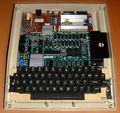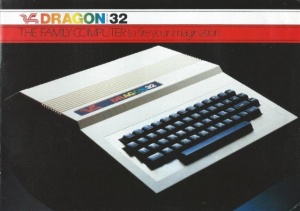Dragon 32
Dragon 32
In the early 1980s, the British home computer market was booming. New machines were released almost monthly. In August 1982, Dragon Data Ltd joined the fray with the Dragon 32. In the private home computer market, where games were a significant driver, the Dragon suffered due to its graphical capabilities, which were inferior to other machines such as the Sinclair ZX Spectrum and Commodore 64. The Dragon was also unable to display lower-case letters easily. Some more sophisticated applications synthesised them using high-resolution graphics modes (in the same way that user-defined characters would be designed for purely graphical applications such as games). Simpler programs just managed without lower case. This effectively locked it out of the then-blooming educational market, which came to be dominated by the Acorn-built BBC Micro. As a result of these limitations, the Dragon was not a commercial success, and Dragon Data Ltd collapsed in June 1984. Despite the demise of the parent company, Dragons still proved quite popular. They had a robust motherboard in a spacious case, and were much more tolerant of home-modification than many of their contemporaries, which often had their components crammed into the smallest possible space.
The Dragon was built around the Motorola MC6809E processor running at 0.89 MHz. For the time, this was a relatively sophisticated 8-bit CPU, with limited 16-bit capabilities. In terms of raw computational power, the Dragon beat most of its contemporary rivals (which were based on the older MOS Technology 6502 and Zilog Z80) but this made little difference in a market where graphical capabilities were much more important to consumers.
Both the Dragon and the TRS-80 Coco were based on a Motorola data sheet design for the MC6883 SAM chip for memory management and peripheral control. The systems were sufficiently similar that a significant fraction of the compiled software produced for one machine would happily run on the other. Software running via the built-in Basic interpreters also had a high level of compatibility, but only after they were re-tokenized (which could be achieved fairly easily by transferring via cassette tape with appropriate options). The Dragon had additional circuitry to make the MC6847 VDG compatible with european 625-line television standards, rather than the US 525-line US standard, and a parallel printer port not present on the Coco.
- Dragon 32
Farm Fax
Farm Fax was part of a Government scheme to get the Farming Community computerised. Dragon 32's where sold (subsidised) to farmers with a software package. To the best of current knowledge the software was to aid farmers in the management of their cattle. The archive has recently obtained a copy of the software that forms this set and can confirm that it was a fairly basic stock control style system for cattle management.
- Farm Fax Dragon
Finlux Dragon
Not a lot is known about this other than Finlux imported UK Dragon 32s and rebranded them by putting their own stickers on top of the originals.
- Finlux Dragon
ATV Dragon
The spanish company Enseñanzas ATV sold rebranded Dragons, bundled with a book and a BASIC course on 12 tapes.
- ATV Dragon
Advertisement
- Dragon 32 "The Family Computer to fire your imagination" brochure by Dragon Data Ltd. (click image to download or open the full brochure in pdf format)
- Dragon 32 leaflet by Eurohard SA. (click image to download or open the full leaflet in pdf format)






